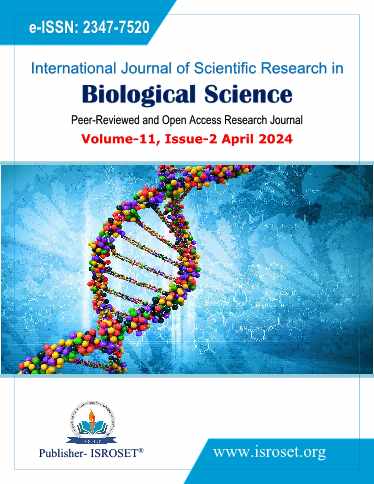Formulation, Standardization and Nutritional Analysis of Beverage and Chutney recipes using Cassia auriculata
Keywords:
Cassia auriculata, formulation, beverage and chutney recipes, nutrition analysis and organoleptic evaluationAbstract
In this study, the effects of Cassia auriculata, a herb, on the formation, standardization, and nutritional analysis (Macro and Micro nutrients) of beverage and chutney recipes were investigated. The flowers, buds, and leaves of the herb exhibited the highest antioxidant activity due to their elevated phenolic and flavonoids content. The aqueous shade-dried powder from the leaves, flowers, and buds was used in the preparation of the beverage mix and chutney mix, which were formulated and standardized using natural preservatives. The edible flowers, buds, and leaves were found to be non-toxic and innocuous, with potential health benefits when consumed in the human diet. The prepared beverage mix and chutney mix were subjected to nutritional analysis, and the organoleptic evaluation by a panel of semi-trained participants showed encouraging acceptability for up to 120 days of storage at room temperature. This study demonstrates the feasibility of utilizing Cassia auriculata as a natural ingredient in the development of shelf-stable and nutritionally-rich beverage and chutney mixes, without the addition of artificial preservatives or flavours. This diversity in formulations also opens avenues for innovative culinary applications and commercial product development, potentially expanding the plant`s consumption. Incorporating this ethno medicinal herb into your regular diet, either as a drink or in a recipe, may help to revitalize your body`s overall system.
References
A. Nille, D. Jaiman, R. Saini, A.Gupta, and Suchita. Medicinal and pharmacological potential of Cassia auriculata: A comprehensive review. Journal of Ethnopharmacology, 266, 113473, 2021.
A. Di Sotto, P. Checconi, I. Celestino, M. Locatelli, S. Carissimi, M. De Angelis, V. Rossi, D. Limongi, C.Toniolo, L. Martinoli, and L. Mosca. Antioxidant and anti-inflammatory properties of Monsonia spp. extracts: Potential therapeutical applications. Plants, Vol.9, Issue.3, pp.288, 2020.
T. N. Musthafa, S.G.I. Tabasum, R. Nisha, and N. Banu. Evaluation of Cassia auriculata flower extracts for analgesic and anti-inflammatory activities. Pharmacognosy Research, Vol.12, Issue.1, pp.89, 2020.
R. R. Kannan, R. Arumugam, & P. Anantharaman. Antibacterial potential of three seagrass species against human pathogens. Asian Pacific journal of tropical medicine, Vol.12, Issue.6, 265, 2019.
V. Anjum, P. Arora, M.H. Ahmad, S.H. Ansari, and S. Sultana. Antidiabetic potential of marker-based standardized Cassia auriculata leaf extract and its application in herbal drug delivery system. Pharmaceutical biology, Vol.56, Issue.1, 192-201, 2018.
P. Palanisamy, P. Kannan, A. Annamalai, and M.R. Ramakrishnan. Antidiabetic and antioxidant potential of hydroalcoholic extract of Cassia auriculata flowers in streptozotocin-induced diabetic rats. Journal of Ayurveda and integrative medicine, Vol.9, Issue.1, pp.23-30, 2018.
B.Vellingiri, K. Jayaramayya, M. Iyer, A. Narayanasamy, V. Govindasamy, B. Giridharan, S. Ganesan, A.Venugopal, D.Venkatesan, H. Ganesan, K. Rajagopalan, P.K.S.M. Rahman, S.G. Cho, N.S. Kumar, and M.D. Subramaniam. COVID-19: A promising cure for the global panic. Science of The Total Environment, 725, 138277, 2020.
R. Balamurugan, V. Duraipandiyan, and S. Ignacimuthu,. Antidiabetic activity of ?-sitosterol isolated from Lippia nodiflora L. in streptozotocin induced diabetic rats. European journal of pharmacology, 858, 172467, 2019.
A. K. Meena, B. Pal, S. Beg, Y. Chandel, and V. Bansal. Quantitative determination of markers and antioxidant activity of Cassia auriculata L. flowers and its pharmaceuticals. Natural product research, Vol.32, Issue.23, pp.2841-2844, 2018.
V. Mathivanan, R. Sundarababu, P. Srinivasan, M. Muthuswamy, A. Subramaniam, & S. Srinivasan. Phytochemical screening and in vitro antioxidant, antibacterial, anti-inflammatory, anti-diabetic activities of ethanolic extract of Cassia auriculata leaves. Journal of King Saud University-Science, Vol.29, Issue.3, pp.368-374, 2017.
Jayasekara, Dumindu, and K.D. Prasanna Gunathilake. “FORMULATION OF INSTANT HERBAL PORRIDGE MIXTURES FROM RANAWARA (Cassia auriculata Linn) LEAVES”. Vol.19, Issue.4, 2018.
J. Sahoo, K.Thummakomma, S. Devi, & S. Pettugani. Formulation and Standardization of Cassia auriculata Beverage Powder. International Journal of Pharmaceutics, 6, pp.431–436, 2021.
D. Govindammal, and M. Seethalakshmi. “An Effect of Cassia auriculata Formulated Buttermilk for Diabetics.” Biosciences 3576, 2021.
K. Abinaya, S. Vasantharuba, and T. Thayalini. “Formulation Palmyrah Jaggery by Incorporating Cassia auriculata Aqueous Extract as a Natural Sweetener for Diabetic Patients.” 978-81-951120-0-5, 2021.
J. K. Sugumar, and P. Guha. Comparative study on the hedonic and fuzzy logic based Organoleptic analysis of formulated soup mix. Future Foods, 5, 100115, 2022.
Downloads
Published
How to Cite
Issue
Section
License

This work is licensed under a Creative Commons Attribution 4.0 International License.
Authors contributing to this journal agree to publish their articles under the Creative Commons Attribution 4.0 International License, allowing third parties to share their work (copy, distribute, transmit) and to adapt it, under the condition that the authors are given credit and that in the event of reuse or distribution, the terms of this license are made clear.







